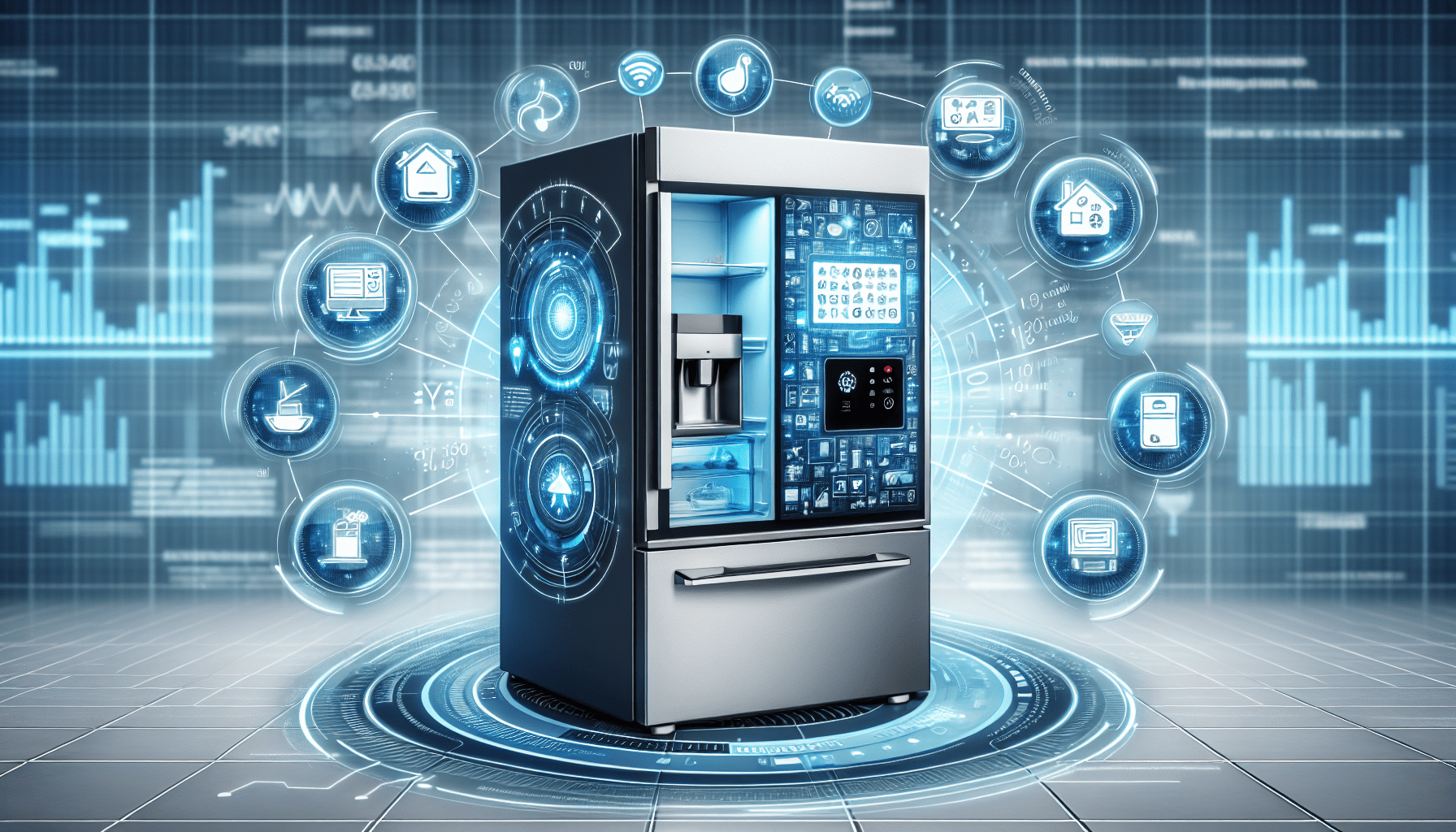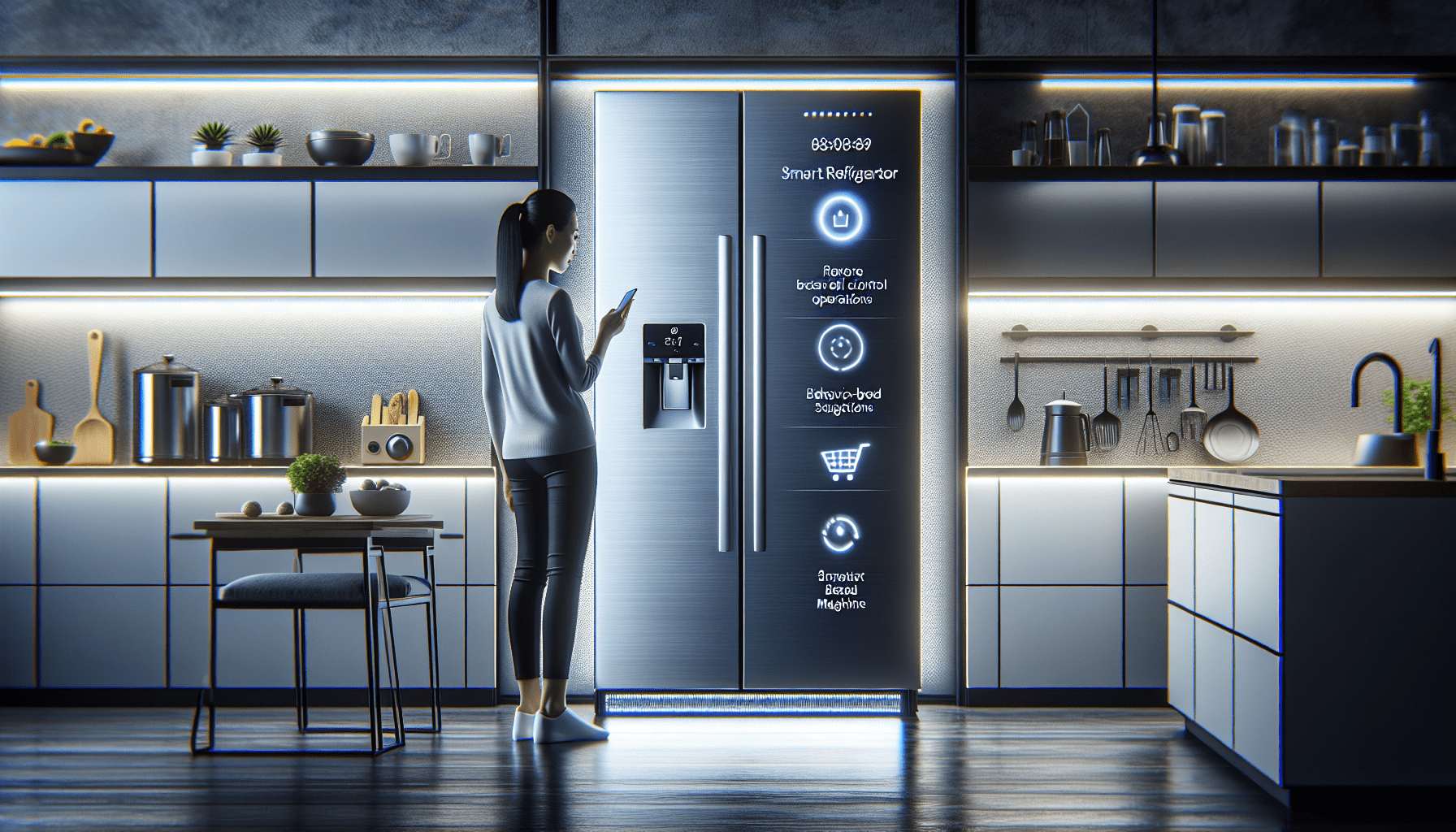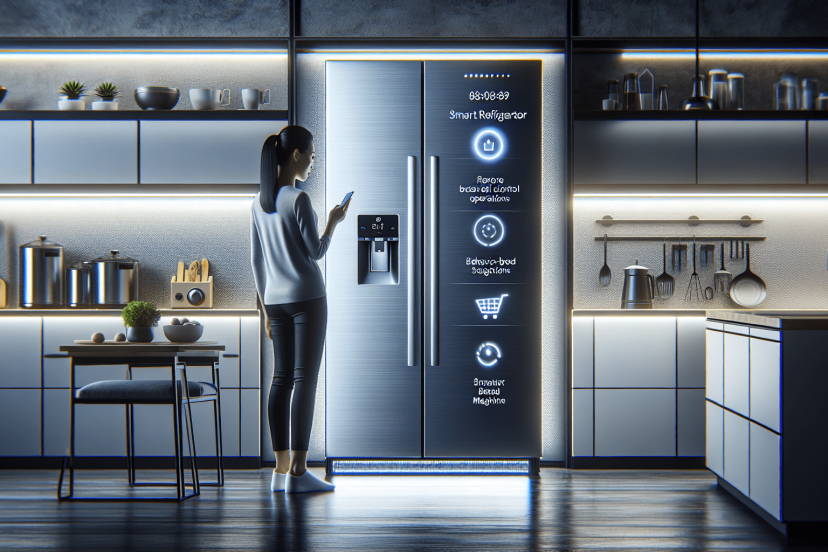What Is The Principle Of Smart Appliances?
Imagine a world where your appliances communicate with each other, making your life easier and more efficient. This is the principle behind smart appliances. These innovative devices, equipped with advanced technology and connectivity, are revolutionizing the way we interact with our everyday household items. From smart refrigerators that can create shopping lists based on what’s inside, to intelligent thermostats that adapt to your preferences, the principle of smart appliances is all about enhancing convenience, saving energy, and creating a seamless, connected home experience.

Definition of Smart Appliances
Explanation and Examples
Smart appliances refer to household devices that have integrated technology, allowing them to connect to the internet and be controlled remotely. These devices are equipped with sensors and processors that enable them to collect data, analyze it, and perform tasks with minimal human intervention. Examples of smart appliances include smart refrigerators, washing machines, ovens, thermostats, and security systems.
Integration of Technology
Smart appliances are built with advanced technology components, such as microcontrollers, sensors, and actuators. These components enable the appliances to communicate with each other and with external devices, facilitating automation and connectivity. By integrating technology, smart appliances can perform tasks independently, adapt to user preferences, and contribute to a more efficient and convenient lifestyle.
Automation and Connectivity
One of the key features of smart appliances is automation. They can be programmed to perform specific tasks based on certain conditions or user preferences. For example, a smart thermostat can learn your temperature preferences and automatically adjust the settings to maintain the desired temperature in your home.
Smart appliances also offer connectivity features, allowing users to control and monitor them remotely through smartphones or other internet-enabled devices. This connectivity enables users to check the status of their appliances, receive notifications, and even control them from anywhere, providing a new level of convenience and flexibility in managing household tasks.
The Benefits of Smart Appliances
Convenience and Time-saving
One of the primary benefits of smart appliances is the convenience they offer. With remote control and monitoring capabilities, you can manage your appliances even when you’re not at home. Forgot to turn off the oven? No problem. Just use your smartphone to switch it off. Additionally, automation features save you time by taking care of routine tasks, such as preheating the oven or starting the dishwasher, allowing you to focus on more important things.
Energy Efficiency
Smart appliances are designed to be energy-efficient, contributing to a greener and more sustainable environment. They can optimize energy consumption by monitoring usage patterns and adjusting settings accordingly. For instance, a smart washing machine can detect the load size and adjust the water and detergent usage accordingly, resulting in reduced energy and water waste. By investing in smart appliances, you can lower your energy bills while minimizing your environmental footprint.
Improved Functionality
Smart appliances offer enhanced functionality compared to their traditional counterparts. They come equipped with additional features that make everyday tasks easier and more enjoyable. For example, a smart refrigerator can provide inventory management, allowing you to keep track of your groceries and even suggest recipes based on the items you have. This improved functionality enhances your overall user experience and simplifies your daily routines.
Enhanced Safety and Security
Smart appliances play a crucial role in ensuring the safety and security of your home. With connected security systems, you can remotely monitor your property through cameras and receive real-time alerts in case of any suspicious activity. Smart ovens and stoves have built-in safety features that automatically turn off after a certain period of inactivity, reducing the risk of accidents. By incorporating smart appliances into your home, you can enjoy peace of mind knowing that your household and loved ones are protected.
Key Features of Smart Appliances
Remote Control and Monitoring
One of the fundamental features of smart appliances is the ability to control and monitor them remotely. Through mobile applications or other control interfaces, you can operate your appliances from anywhere, allowing you to save time and conveniently manage your household tasks. Whether it’s adjusting the temperature of your thermostat, setting the cooking time for your oven, or starting your washing machine, remote control ensures that you have complete control over your appliances regardless of your location.
Internet Connectivity
Smart appliances utilize internet connectivity to enable remote control and provide access to various online services. They can connect to the internet through Wi-Fi, allowing you to access and control them using your smartphone or other internet-enabled devices. This connectivity also enables smart appliances to receive software updates, ensuring that they stay up-to-date with the latest features and improvements.
Voice Control
Voice control is becoming increasingly popular in smart appliances, thanks to advancements in voice recognition technology. With voice control capabilities, you can simply give voice commands to your appliances, eliminating the need for manual input or using a smartphone. For example, you can ask your smart refrigerator to add items to your shopping list or instruct your smart thermostat to adjust the temperature without lifting a finger. Voice control adds an extra layer of convenience and hands-free operation to your smart appliances.
Smart Home Integration
Smart appliances can seamlessly integrate with other smart home devices and systems, creating a cohesive and interconnected ecosystem. Through smart home platforms like Amazon Alexa or Google Assistant, you can create automation routines and control multiple devices simultaneously. For instance, you can configure a routine that turns off all the lights, locks the doors, and adjusts the thermostat when you leave the house. This integration enhances the overall functionality and efficiency of your smart appliances, making them even more valuable in your daily life.
Data Collection and Analysis
Smart appliances are equipped with sensors that collect data on usage patterns, energy consumption, and user preferences. This data can be used to analyze and optimize the performance of the appliances, leading to improved efficiency and functionality. For example, a smart washing machine can learn your laundry habits and suggest the most energy-efficient cycles, resulting in significant energy savings over time. Data collection and analysis also enable manufacturers to gather valuable insights about user behavior and preferences, helping them to design better products in the future.

The Role of Artificial Intelligence (AI)
AI-powered Functions
Artificial Intelligence (AI) plays a crucial role in enhancing the capabilities of smart appliances. By leveraging AI algorithms and machine learning techniques, smart appliances can understand user behavior, adapt to user preferences, and perform complex tasks with minimal human intervention. For example, AI-powered smart thermostats can learn your temperature preferences and create personalized schedules to optimize energy consumption and ensure comfort.
Machine Learning Algorithms
Machine learning algorithms allow smart appliances to analyze data and learn from past experiences, enabling them to make accurate predictions and recommendations. For instance, a smart refrigerator can learn your shopping habits and predict when you will run out of certain items, automatically adding them to your shopping list. Machine learning algorithms also allow the appliances to adapt to changing conditions and adjust their settings accordingly, enhancing their overall performance and efficiency.
Predictive Analysis
With AI-driven predictive analysis, smart appliances can anticipate user needs and offer proactive solutions. For example, a smart oven can preheat itself based on your cooking history, ensuring that it’s ready for use when you need it. Predictive analysis also allows appliances to detect and diagnose potential issues, enabling timely maintenance or repairs. By utilizing AI, smart appliances can offer a more personalized and efficient user experience.
Examples of Smart Appliances
Smart Refrigerators
Smart refrigerators are equipped with features that go beyond traditional cooling capabilities. They come with touchscreens, built-in cameras, and inventory management systems, allowing you to keep track of your groceries and plan meals more effectively. Some smart refrigerators can even connect to online recipe databases, providing suggestions based on the ingredients you have available. With advanced cooling technologies and energy-saving features, smart refrigerators offer convenience, efficiency, and enhanced food management.
Smart Washing Machines
Smart washing machines simplify the laundry process by offering advanced features and intuitive controls. They can detect the size and type of load, adjust water and detergent usage accordingly, and optimize washing cycles for energy savings. Some smart washing machines also provide notifications on the progress of your wash cycle, allowing you to better plan your time. With their efficiency, convenience, and improved cleaning capabilities, smart washing machines revolutionize the way we do laundry.
Smart Ovens
Smart ovens offer a range of features that make cooking more precise and convenient. They can be controlled remotely, allowing you to preheat the oven or adjust the cooking time while you’re away. Some smart ovens have built-in recipe guides or connectivity to recipe apps, providing step-by-step instructions and ensuring perfectly cooked meals. With their advanced temperature control and cooking capabilities, smart ovens take the guesswork out of cooking and enable you to achieve culinary excellence.
Smart Thermostats
Smart thermostats are designed to optimize energy usage and provide personalized comfort. They learn your temperature preferences and daily routines, creating heating and cooling schedules that maximize energy efficiency. Through remote control and integration with smart home systems, you can adjust the temperature settings from anywhere and create automation routines based on your needs. Smart thermostats not only save energy but also provide a comfortable living environment tailored to your preferences.
Smart Security Systems
Smart security systems enhance the safety and security of your home by offering advanced monitoring and control features. They can include cameras, motion sensors, door/window sensors, and alarms, allowing you to monitor your property remotely and receive real-time alerts in case of any unusual activities. Some smart security systems integrate with smart locks, enabling you to lock or unlock your doors remotely. With their comprehensive security capabilities, smart security systems provide peace of mind and protect your loved ones and belongings.
Challenges and Concerns
Data Privacy and Security
One of the major concerns with smart appliances is the risk of data privacy and security breaches. As these appliances collect and transmit data, there is a possibility of unauthorized access or misuse of personal information. Manufacturers and users need to ensure that proper security measures are in place to protect sensitive data. It’s important to choose appliances from reputable manufacturers that prioritize data privacy and implement robust security protocols.
Compatibility Issues
Another challenge is compatibility among different smart appliances and devices. With a growing number of manufacturers and communication protocols, not all devices may work seamlessly together. Users may face challenges in integrating various smart devices into a cohesive smart home ecosystem. It’s crucial to consider compatibility and choose appliances that support open standards or have compatibility with popular smart home platforms to ensure smooth integration.
Initial Cost and Affordability
The initial cost of smart appliances can be higher compared to traditional appliances. The advanced technology and additional features come at a price. However, it’s important to consider the long-term benefits and potential savings that smart appliances offer in terms of energy efficiency and convenience. Additionally, as the market for smart appliances grows and technology advances, prices are expected to become more affordable, making them accessible to a wider range of consumers.
Future Trends in Smart Appliances
Integration with Smart Grids
One of the future trends in smart appliances is integration with smart grids. Smart grids are intelligent electrical grids that use real-time data and advanced communication technologies to enhance energy efficiency and reliability. By connecting to smart grids, smart appliances can communicate with the energy grid, optimizing their energy usage based on current rates and demand. This integration can help reduce overall energy consumption and contribute to a more sustainable energy infrastructure.
Interconnectivity among Different Appliances
The future of smart appliances lies in their interconnectivity. As the number of smart devices in our homes increases, the ability to create an interconnected ecosystem becomes even more important. This interconnectivity enables appliances to communicate and collaborate with each other, further automating routine tasks and providing a seamless user experience. For example, a smart refrigerator can communicate with a smart oven to preheat itself based on the ingredients you’ve taken out of the fridge, ensuring a smooth cooking process.
Enhanced User Experience
Smart appliances will continue to evolve to provide an even better user experience. Manufacturers are investing in improving the interfaces, adding more intuitive controls, and enhancing the overall design of smart appliances. Integration with voice assistants and personalized recommendations based on user preferences will become more prevalent. The goal is to make smart appliances not only technologically advanced but also user-friendly and intuitive, making them an indispensable part of modern living.
Smart Appliances and Sustainable Living
Reduced Energy Consumption
Smart appliances contribute to reduced energy consumption by optimizing their usage patterns and adjusting settings for energy efficiency. They can detect user behavior, adapt to changing conditions, and make energy-saving recommendations. By significantly reducing energy waste, smart appliances contribute to a greener and more sustainable environment.
Optimized Resource Management
Smart appliances help optimize resource management, particularly in the case of water usage and food waste. Through sensors and automation, they can minimize water consumption by detecting load sizes and adjusting water usage accordingly. Smart refrigerators with inventory management systems help reduce food waste by notifying users about expiration dates and suggesting recipes based on available ingredients. These resource-efficient practices contribute to sustainable living and responsible resource management.
Contribution to a Greener Environment
By reducing energy consumption and optimizing resource usage, smart appliances play a crucial role in building a greener environment. The collective impact of millions of energy-efficient appliances can significantly reduce greenhouse gas emissions and help combat climate change. Smart appliances empower individuals to make sustainable choices and actively participate in efforts to create a cleaner and healthier planet for future generations.
Factors to Consider When Purchasing Smart Appliances
Compatibility with Existing Devices
Before purchasing smart appliances, it’s essential to consider their compatibility with existing devices and systems in your home. Ensure that the appliances can communicate with your smart home platform or other devices through compatible protocols, such as Wi-Fi, Bluetooth, or Zigbee. This compatibility will enable seamless integration and ensure that all your smart devices work together to create a cohesive ecosystem.
Long-term Cost and Savings
While smart appliances may have a higher upfront cost, it’s crucial to assess the potential long-term cost savings they offer. Calculate the estimated energy savings and convenience benefits over the lifespan of the appliance to determine the overall cost-effectiveness. Consider factors such as energy efficiency ratings, warranty coverage, and maintenance costs to make an informed decision about the long-term value of the appliance.
Reliability and Durability
Ensure that the smart appliances you choose are from reputable manufacturers known for their reliability and durability. Read reviews and consider user feedback to gauge the performance and longevity of the appliances. Investing in reliable and durable appliances will minimize the risk of breakdowns and ensure that you can enjoy their benefits for years to come.
Brand Reputation
The reputation of the brand is an important factor to consider when purchasing smart appliances. Choose brands that have a proven track record in the industry and are known for their quality and customer support. Established brands often have better customer service, warranty coverage, and access to software updates, ensuring a seamless user experience and peace of mind.
Conclusion
Smart appliances are revolutionizing the way we live by bringing advanced technology into our homes. With their convenience, energy efficiency, improved functionality, and enhanced safety features, they offer a range of benefits that enhance our daily lives. Through remote control, automation, and AI-powered functions, smart appliances simplify household tasks, save time and energy, and contribute to sustainable living.
As technology continues to advance, future trends in smart appliances include integration with smart grids, interconnectivity among different appliances, and an enhanced user experience. By leveraging AI and machine learning, smart appliances will become even smarter, adapting to user preferences and predicting needs. They will play a vital role in creating a greener environment by reducing energy consumption and optimizing resource management.
When purchasing smart appliances, it’s essential to consider compatibility, long-term cost and savings, reliability, and brand reputation. Choosing the right appliances ensures seamless integration, durability, and a positive user experience.
In conclusion, smart appliances are more than just convenient gadgets; they are transformative tools that make our lives easier, more efficient, and more sustainable. With their continued advancements, smart appliances will remain an integral part of modern living, shaping the future of home automation and contributing to a better quality of life.




